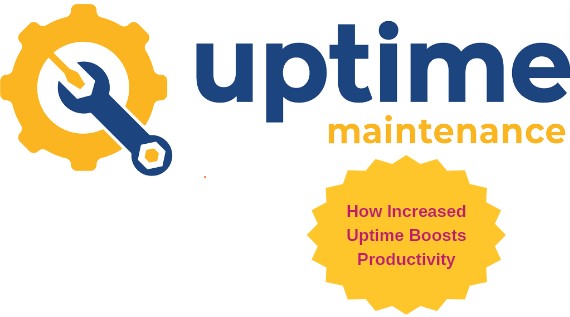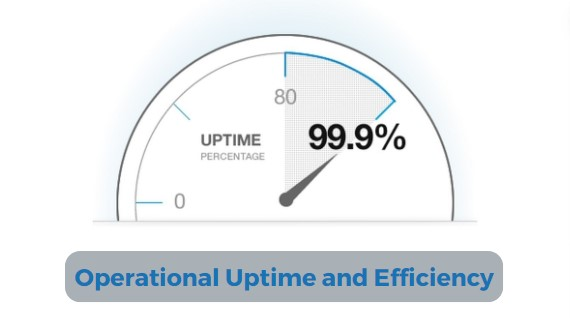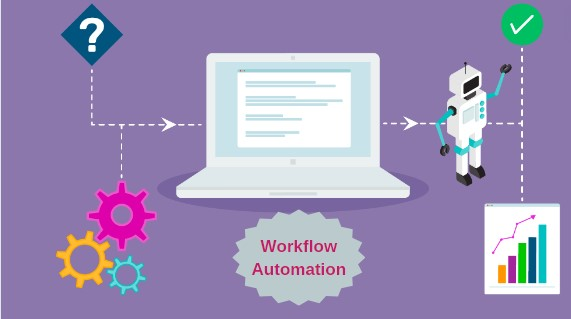
5 ways to boost equipment uptime
Pratik Lohiya |
26 Jan 2024 |
12:48 PM
- Importance of Equipment Uptime
- Impact on Bottom Line
- Understanding Equipment Uptime
- Top 5 Ways to Boost Equipment Uptime
- Operational Uptime and Efficiency
- Role of Facility Management in Brand Uptime
- Facility Management in Industries
- Conclusion

Implementing a Robust Preventive Maintenance Program
Madhurima Sanyal 15 Mar 2024 | 11:26 AMDiscover the key steps to build a robust preventive maintenance program, including identifying maintenance needs, setting performance targets, creating schedules, leveraging technology, training teams, establishing procedures, and monitoring progress...
Ensuring robust equipment uptime is a cornerstone of an effective maintenance program. In the dynamic landscape of industrial and manufacturing sectors, the seamless functionality of machinery directly translates to operational efficiency and, consequently, a healthier bottom line. Equipment uptime refers to the duration during which a particular piece of machinery operates optimally without any unplanned interruptions.
Importance of Equipment Uptime
In the intricate web of production processes, equipment uptime emerges as a critical factor influencing overall productivity. When machinery functions reliably and consistently, it minimizes the occurrence of equipment failure, reducing the need for reactive maintenance and mitigating unplanned downtime. This not only enhances the efficiency of day-to-day operations but also extends the lifespan of equipment, ultimately resulting in substantial cost savings and optimized plant operations.
Impact on Bottom Line
The financial implications of robust equipment uptime are profound. A well-maintained and continuously operating machinery fleet not only avoids costly repairs and replacements but also fosters a proactive maintenance culture. This, in turn, contributes to the optimization of operational costs and resource allocation.
Moreover, increased equipment reliability positively influences customer satisfaction by ensuring timely delivery and consistent product quality. As a result, businesses can carve out a competitive edge, solidifying their position in the market and boosting their overall profitability.
Understanding Equipment Uptime
In industrial operations, understanding equipment uptime is paramount for maintaining a seamless workflow. It is a metric that gauges the operational efficiency of machinery, measuring the duration during which equipment operates without disruptions. This metric encapsulates the reliability and effectiveness of crucial assets, serving as a key performance indicator for businesses.
In practical terms, it signifies the percentage of time a machine spends in full operation, performing its designated tasks. A high equipment uptime indicates a well-maintained and robust fleet, ensuring that production processes run smoothly. On the contrary, low equipment uptime suggests frequent breakdowns, leading to reactive maintenance and unplanned downtime.
-
How Increased Uptime Enhances Business Performance
Achieving optimal equipment uptime requires preventive maintenance programs, reactive maintenance plans, and the utilization of cutting-edge technologies. Elevating this metric goes beyond statistical improvements; it directly correlates with enhanced business performance.
When machinery functions seamlessly, it reduces the likelihood of equipment failure and breakdowns, thereby increasing overall productivity. This operational continuity is pivotal for meeting production deadlines, fulfilling customer orders promptly, and maintaining a competitive edge in the market.
Moreover, it positively influences the lifespan of assets, postponing the need for costly replacements. This, in turn, optimizes resource allocation, as capital earmarked for emergency repairs can be redirected to strategic growth initiatives.
Top 5 Ways to Boost Equipment Uptime

-
Priority-Driven Preventative Maintenance - Proactively schedule inspections and replacements based on critical equipment, mitigating potential breakdowns and extending equipment lifespan.
-
Outcome-Based Service Plans for Reactive Maintenance - Swiftly respond to unexpected failures with targeted service plans, prioritizing critical assets to minimize downtime and restore operations efficiently.
-
Avoiding Repair Delays with Strong Supply Chain Plans - Establish robust supply chain strategies, ensuring timely access to replacement parts, not to risk equipment failures.
-
Encouraging Best Practices for Equipment Operation - Implement comprehensive training programs and operational guidelines to foster a culture of responsibility, enhancing equipment reliability through well-trained operators.
-
Utilizing Technology for Smarter Maintenance - Embrace predictive maintenance and automation solutions, leveraging data analytics for proactive intervention and streamlining preventive maintenance tasks to ensure more efficient and intelligent equipment maintenance program.
Operational Uptime and Efficiency

Implementing Preventive Maintenance
To maximize operational efficiency, businesses leverage preventive maintenance, guided by Computerized Maintenance Management Systems (CMMS) and predictive maintenance insights. By harnessing extensive data, including historical performance data and sensor readings, organizations develop preventive maintenance programs. These data-driven programs enable precise interventions, optimizing repair and replacement timing.

The adoption of preventive maintenance, facilitated by CMMS, yields diverse benefits. It minimizes unplanned downtime, extends equipment lifespan, and strategically plans maintenance activities. This proactive approach ensures seamless alignment with production schedules, optimizing resource allocation. The integration of predictive maintenance into the maintenance program transforms the operational landscape, allowing businesses to unlock higher levels of uptime and efficiency.
Embracing Technology and Automation

Embracing cutting-edge technology and automation solutions is a pivotal stride towards elevating operational efficiency and equipment life. Automation, in the form of advanced control systems and robotics, streamlines routine maintenance tasks, reducing the burden on human resources and ensuring consistent, error-free operations. This not only enhances efficiency but also contributes to a safer work environment.
Furthermore, integrating machine learning into maintenance practices adds a layer of intelligence to the process. By continuously analyzing data patterns and equipment performance, machine learning algorithms can predict potential failures, allowing for proactive and strategic intervention. This intelligent approach minimizes downtime, extends the life of critical assets, and ultimately transforms maintenance into a data-driven, efficient, and forward-looking facet of operations.
Optimizing Supply Chain Management
Optimizing supply chain management is a critical element in ensuring seamless equipment uptime. An efficient and well-orchestrated supply chain ensures the timely availability of replacement parts, reducing the duration of equipment downtime. Establishing strong relationships with reliable suppliers, implementing just-in-time inventory strategies, and leveraging digital tools for real-time tracking contribute to the overall resilience of the supply chain.

This not only minimizes delays in procuring essential components but also allows for more strategic planning of maintenance activities. By optimizing supply chain management, businesses can strike a delicate balance between reducing costs and maintaining a ready inventory, ultimately enhancing equipment life and contributing to the overall efficiency of the production process.
In a landscape where time is a critical factor, a streamlined supply chain becomes a cornerstone in the pursuit of operational excellence and sustained productivity. In a landscape where time is a critical factor, a streamlined supply chain becomes a cornerstone in the pursuit of operational excellence and sustained productivity.
Streamlining Workflows
Efficient workflows are central to maintain equipment warranties. Streamlining workflows involves a meticulous evaluation and enhancement of every step in the production process, ensuring seamless coordination between different stages. By identifying and eliminating bottlenecks, redundant tasks, and unnecessary delays, businesses can significantly reduce the risk of disruptions to equipment operation. This not only enhances productivity but also contributes to a more agile response to maintenance needs.

Implementation of digital tools, such as workflow automation software, plays a key role in this process, enabling the smooth flow of information and tasks across departments. Streamlining workflows not only improves the overall efficiency of operations but also positively impacts equipment reliability by fostering a synchronized and proactive approach to maintenance.
As businesses strive for operational excellence, the optimization of workflows emerges as a fundamental strategy to bolster equipment uptime and ensure sustained productivity.
Enhancing Planning with Data Analytics
Enhancing planning with data analytics is a strategic imperative in the pursuit of improved equipment uptime. By harnessing the power of data, businesses gain invaluable insights into the performance of their assets, allowing for more informed and proactive decision-making.
Data analytics enables the identification of patterns, trends, and potential issues, empowering organizations to develop precise maintenance schedules and resource allocation strategies. Utilizing data analytics for planning is akin to having a roadmap that guides businesses towards minimizing downtime, maximizing equipment reliability, and achieving operational excellence.
Role of Facility Management in Brand Uptime
Facility management plays a pivotal role in ensuring brand uptime, particularly concerning equipment reliability. The maintenance team, a cornerstone of facility management, implements preventive and predictive maintenance programs to optimize equipment performance. By adhering to manufacturer specifications, the maintenance team not only extends equipment life but also ensures compliance with warranties.
Facility Management in Industries
In the context of food processing plants, where efficiency is paramount, maintaining a typical food packaging line is crucial. Facility management strategies, including predictive maintenance, are integral ways to improve equipment and guarantee that machinery operates efficiently. Ultimately, the proactive role of facility management becomes synonymous with brand reliability and success.
Conclusion
Maintaining equipment uptime demands a multifaceted approach anchored in key strategies. Prioritizing preventive maintenance measures and optimizing maintenance processes are vital for sustained reliability. Properly trained employees, equipped with the knowledge to handle equipment properly, become indispensable assets.

Implementing repair and replacement parts strategies, guided by key performance indicators, ensures swift responses to unforeseen challenges. Collaborating with a trusted equipment vendor enhances access to quality components.
Collectively, these measures not only improve equipment reliability but also underscore the significance of continuous employee training in fostering a culture of operational excellence. As businesses embrace these practices, they pave the way for heightened uptime, reduced costs, and overall operational success.